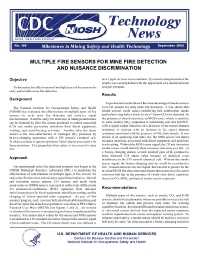Mining Publication: Technology News 498 - Multiple Fire Sensors for Mine Fire Detection and Nuisance Discrimination
Original creation date: September 2002
In an effort to determine the effectiveness of multiple types of fire sensors for early and reliable mine fire detection, the National Institute for Occupational Safety and Health (NIOSH), has evaluated multiple sensors for early mine fire detection and nuisance signal discrimination. Optical and ionization smoke sensors, carbon monoxide sensors, and metal oxide semiconductor (MOS) sensors were used to collectively differentiate fire products-of-combustion (POC) signatures from nuisance emissions produced by diesel equipment, metal flame cutting, and the charging of battery-operated mine equipment. Experimental results showed the clear advantage of smoke sensors over carbon monoxide sensors for early mine fire detection. NIOSH recommends that multiple types of fire sensors, such as smoke, carbon monoxide, and MOS sensors, should be implemented whenever possible to reduce the risk of nuisance fire alarms and provide early mine fire warning capability based on the expected fire and nuisance emissions sources. A rule-based system derived from the expected sensor responses could be implemented into a mine atmospheric warning system. To enhance miner safety, a smoke sensor should be used in a conveyor belt entry for early fire detection and at a battery-charging station to eliminate false chemical cell carbon monoxide alarms. With the operation of diesel equipment in underground mines, a NOx-sensitive MOS sensor can be used to discriminate diesel emissions and provide a positive indication of a fire. A combination of a carbon monoxide sensor, smoke sensor, and MOS NOx-sensitive sensor is one possible sensor combination for early mine fire detection and nuisance signal discrimination.
Authors: JC Edwards
Technology News - September 2002
NIOSHTIC2 Number: 20022115
U.S. Department of Health and Human Services, Public Health Service, Centers for Disease Control and Prevention, National Institute for Occupational Safety and Health, Technology News 498, 2002 Sep :1-2
See Also
- In Mine Evaluation of Discriminating Mine Fire Sensors
- In-Mine Evaluation of Smoke Detectors
- In-Mine Evaluation of Underground Fire and Smoke Detectors
- Mine Fire Detection in the Presence of Diesel Emissions
- Mine Fire Detection Under Zero Airflow Conditions
- Mine Fire Source Discrimination Using Fire Sensors and Neural Network Analysis
- Multiple Type Discriminating Mine Fire Sensors
- Neural Network Application to Mine-Fire Diesel-Exhaust Discrimination
- Rapid Detection and Suppression of Mining Equipment Cab Fires
- Real-time Neural Network Application to Mine Fire - Nuisance Emissions Discrimination
- Content source: National Institute for Occupational Safety and Health, Mining Program


 ShareCompartir
ShareCompartir
